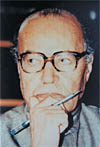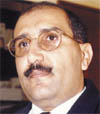A fan of Yemeni architecture, [Archives:1997/47/Interview]
Jos-Marie Bel: “Yemen has 6 distinct architectural styles.”
Jos-Marie Bel is a French architect, ethnologist and artist. He is also a specialist on Yemen, or what is dubbed as Yemenologist. Bel first visited Yemen 23 years ago when he met the late President Ibrahim Al-Hamdi, who encouraged the young artist. He carried out several extensive studies about Yemeni architecture, ethnology, and arts, some of which have been published in books and articles. In his 130 visits to Yemen, he made many long journeys. He was instrumental in restarting the now closed House of Rimbaud in Aden. He displayed his work on Yemeni architecture and people in France and a few other countries. Bel is currently in Yemen to arrange a two-week exhibition at the French Cultural Center in Sanaa. Dr. Salah Haddash met Mr. Bel and filed the following interview.
Q: How and why were you attracted to Yemen? What made it tick? A: For me it is a long story. Being in Yemen today is like being in my own country (France). I am very happy and free in Yemen. I very much like this country. I spent the first twelve years of my life with my parents in Morocco. For me, it is absolutely normal to be in Arab countries. I travelled extensively in Africa and the Middle East. The first time I came to Yemen was in January, 1974. The people here are very friendly and I think that it is a very fantastic place. By the way, there are many similarities between Yemen and Morocco. I discovered that there were very very few books and studies about Yemen and almost nothing on the architecture. So I decided it is good to know and to show the country to the rest of the world. I met with UNESCO officials and organized things to present Yemen to the world, and explain this especially nice country.
Q: Could you briefly tell us about your work? A: I have an atelier in France. It is a workshop where I make architectural maquettes, some of which are of traditional Yemeni houses.
Q: I understand that you published a few books on Yemen. What are they? A: I published four books on Yemen. The first one was ten years ago about the architecture and people of Yemen. I also published a catalogue on four big exhibitions in France, which were held in the “Institut du Monde Arabe” four years ago. The title was “3000 Years of Architecture in Yemen.” One and a half years ago, I published the first book about botanical diversity in Yemen in French with short summaries in English and Arabic. It is about flowers, plants, frankincense, qat, myrrh and many other plants. I made a special trip to Yemen with Theodore Monod – the very best specialist of the world in this field. The last book has just come out. Written in French, it is on Yemen’s architecture. I spent more than 10 years of my life to research and write this book.
Q: Have you studied the botany of Socotra? A: For me, this is a frustrating question because I had three occasions to go to Socotra, but each time something happened to block it. At one time, I was already in the plane from Aden but could not go because of engine trouble. I have not been to Socotra, and it is still a dream to see it. It is a very interesting place. I know a lot about it and we have to make some studies. I feel that Socotra is an island of tranquility.
Q: What about the rare flowers and plants in Yemen about which you wrote? A: When Yemen separated from Africa – it is still moving away at the rate of some 2 centimeters every year – many very rare plants were left on the mainland and on islands such as Socotra. There are about 3 thousand special plants of which 2 hundred specimen are endemic. I believe there may still be some plants that have not yet been discovered in Yemen. There is a special market for medicina herbs in Sanaa. People traditionally use plant herbs to treat medical problems. For foreigners, many of these plants are still a mystery. They want to know the plants of Yemen. Coffee, qat, and myrrh for example, are widespread plants in Yemen. We see people chewing qat but we don’t understand the nature of the plant. Qat has very bad properties and some good ones. My book tries to explain that. I hope in the future, specialists studying the fauna and flora of the region, especially the ones in Dhofar and Hadhramaut, will continue to provide the historic link in this field.
Q: Could you tell us about the distinct architectural features? A: Yemen is one of the countries which has a well-developed architecture. The people have acquired this tradition themselves. They feel this tradition for a very long time. The new buildings are very special and interesting and of a very good quality. Yemeni people at the time of Mareb, Sabaa and Shabwa liked to build strong buildings with solid materials. At the beginning of Islam, the people of Yemen still continued this tradition. We actually can determine 6 very distinct styles of architecture and about more than 50 hybrid designs in Yemen. Every region has its own character.
Q: What are these types? A: The first one is Sanaani. It is distinguished by its columns, bricks and special plaster (white-wash) decorations. Another specific one is the mountain architecture. There are different types of this, as the ones in Jibla, Thula, Khowlan, Taiz, Manakha, Zabeed, Saada, and Hajjah. This is a specific type made only of stones without much plaster. This Yemeni type of architecture was introduced into Mauritania, Morocco, and Algeria by Yemeni migrant builders. You can find this Yemeni type since the 7th century. There are different types again in Zabeed that are absolutely unique in the world. They are decorated with white bricks and the interiors are extraordinarily beautiful. There is another type in Tihama – the Akhdam African houses. This type is simple but the decorations inside are very good. There is still another type in Shibam, Hadhramaut which is very interesting but without much decoration. The specimen in Mukalla and Tareem where there are castles since the 19th century are especially attractive. Also, we can say there is a modern architectural type in Aden which is British. It is not Yemeni in design but it is very interesting too because it reflects the history of that area. In Zabeed, for example, there are private gardens inside a courtyard where the family can have privacy. It is a traditional, Spanish style, which was originally influenced by the Islamic style. Also in Zabeed, there are separate houses or buildings within the same family lodging. For example there is a “mafraj” and “diwan” for men, and another built separately for women. So for one family, it is possible to have 3 or 4 separate houses but with just a single decorated facade. It is usually decorated with bricks and the ceiling is covered with lively colored paintings with many designs. For example, there are many Islamic designs influenced by the Indian style and also some figurative designs.
Q: Do you think these buildings and the architecture can survive? A: There are many points to consider. For example, around the 1980s, I saw modern architecture which was not always very good. People started using different input, such as cement, etc. Clever architects and builders are able to blend traditional architecture with modern material.
Q: What about the ‘qamariah’ or the half circle of stained glass on top of almost every window in Yemen? A: While I was conducting a comparative study on the Yemeni and French revolutions, I worked with a Yemeni ‘osta’ or master builder in Sanaa who makes ‘qamarias.’ I counted between 5 and 6 thousand types of qamaria in Yemen. They are all different and handmade. I had an exhibition in Franceon Yemeni ‘qamarias.’ The French public was quite surprised because in Europe people like stained glass windows. They also admired this technique which is very original. In Yemen, there are about 15 types of qamaria motifs – flowers, animals, geometric designs, etc.
Q: How about the concept of space? A: Everything is close to the ground, unlike the European furniture. I have a “mafraj” in Paris and my friends like it very much. By sitting near the floor you have a greater contact with people, and can look out the window. It is more comfortable, and we can better utilize the space.
Q: How is Yemeni architecture evolving? A: When Imam Yahya built a palace with traditional architecture, such as those in Hodeida near the sea or in Taiz near the Saber mountain, the people started copying the style when building new homes. The builders like a challenge to do something new. Not all traditional buildings however, are good. Sometimes one part is good and another is not very interesting. Balconies, for example, have been recently introduced into Yemen. New types of qamaria are also being introduced.
Q: What is the influence of other modern styles on current Yemeni architecture? A: The house interior, for example, has changed in the last ten years. The geographic location of a country plays a major role in the way it influences others and in its being influenced. Yemeni architecture today is inspired by Arab, African, Indian, and of course, Euro-American styles.
——
[archive-e:47-v:1997-y:1997-d:1997-11-24-p:./1997/iss47/intrview.htm]


